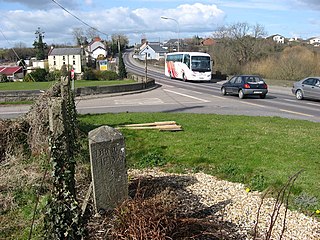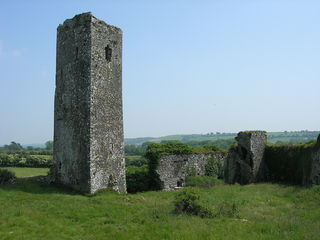
Tattershall Castle is a castle in Tattershall, Lincolnshire, England, about 12 miles (19 km) north east of Sleaford. Since 1925 it has been in the care of the National Trust.

Trim Castle is a castle on the south bank of the River Boyne in Trim, County Meath, Ireland, with an area of 30,000 m2. Over a period of 30 years, it was built by Hugh de Lacy and his son Walter as the caput of the Lordship of Meath. The Irish Government currently own and are in charge of the care of the castle, through the state agency The Office of Public Works (OPW).

Julianstown is a village in County Meath, Ireland. It is located near Drogheda on the R132 regional road. In 1641, the Battle of Julianstown was fought here during the Irish Rebellion of 1641.

Mornington House was the Dublin social season Georgian residence of the Earls of Mornington. It is Number 24 Merrion Street, close to Leinster House, the former city residence of the Dukes of Leinster, where the Irish parliament now sits.

Naul, is a village, townland, and civil parish at the northern edge of Fingal and the traditional County Dublin in Ireland. The Delvin River to the north of the village marks the county boundary with County Meath. Naul civil parish is in the historic barony of Balrothery West.

Francis Johnston was an Irish architect, best known for building the General Post Office (GPO) on O'Connell Street, Dublin.
Ballymore Castle in Lawrencetown, County Galway, Ireland was originally a 15th-century tower house belonging to O'Madden. A house was added in 1620, and the castle has been much altered since then.

Ballincollig Castle is a Norman castle to the south of the town of Ballincollig, County Cork, Ireland built after the Norman invasion of Ireland. In its prime, the castle was inhabited by the Barrett family, who had control of the local area. The castle still stands today, albeit largely in ruin. The original keep still remains, as does most of the curtain wall and two towers.

Dunsany Castle, Dunsany, County Meath, Ireland is a modernised Anglo-Norman castle, started c. 1180 / 1181 by Hugh de Lacy, who also commissioned the original Killeen Castle, nearby, and the famous Trim Castle. It is one of Ireland's oldest homes in continuous occupation, possibly the longest occupied by a single family, having been held by the Cusack family and their descendants by marriage, the Plunketts, from foundation to the present day. The castle is surrounded by its demesne, the inner part of the formerly extensive Dunsany estate. The demesne holds a historic church, a walled garden, a stone farm complex, and an ice house, among other features, and is home to a wide range of fauna.

Mornington is a coastal village on the estuary of the River Boyne in County Meath, Ireland approximately 5 km downriver from the centre of Drogheda. Together with the neighbouring villages of Laytown and Bettystown it comprises the census town of Laytown-Bettystown-Mornington, with a combined population of 10,889 at the 2011 Census and 11,872 at the 2016 Census. Mornington is part of the wider area collectively known as East Meath.
The High Sheriff of Meath was the British Crown's judicial representative in County Meath, Ireland, from the conquest until 1922, when the office was abolished in the new Free State and replaced by the office of Meath County Sheriff.
Jenet Sarsfield, Baroness Dunsany was an Anglo-Irish noblewoman who lived in Dublin during the Tudor era. She is chiefly memorable for having married no less than six husbands.

Robert Shilyngford, or Shillenford was Mayor of Dublin in 1534–35. Apart from his tenure in this office, he is mainly remembered as the first of the six husbands of Jenet Sarsfield.
Sir John Cornwalsh was an Irish judge who held the office of Chief Baron of the Irish Exchequer. His tenure was notable for the fact that he succeeded his father as Chief Baron, and for his long struggle to retain the office against a rival claimant, Michael Gryffin. He is also remembered as the builder of Dardistown Castle in County Meath.
John Bathe (1536-1586) was an Irish lawyer and statesman of the sixteenth century. He held several important offices, including that of Attorney General for Ireland and Chancellor of the Exchequer of Ireland. He was a member of a prominent landowning family from County Dublin, and himself added to the family estates. His children included the Jesuit William Bathe, who was a noted musicologist.

Athcarne Castle is a ruined Elizabethan castle outside the town of Duleek in County Meath, Ireland.

The River Nanny, also called the Nanny Water, is a river that flows from Kentstown into the Irish Sea at Laytown. The river is known for its trout fishing, and its estuary on the Irish sea provides a haven for wintering birds.

Dunsoghly Castle is a castle and a National Monument located in the civil parish of St. Margarets, in Fingal, Ireland.

Athlumney Castle is a tower house and fortified house and a National Monument in Navan, Ireland.

Liscartan is the county town of County Meath, and province of Leinster, Republic of Ireland. It is 2 three-quarters miles northwest of Navan, on the river Blackwater, and on the former mail road from Dublin to Enniskillen.

















